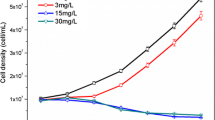Abstract
To explore potassium toxicity in Microcystis sp., growth, chlorophyll a, carotenoid and phycocyanin content, uptake of nitrate, phosphate and ammonium and activities of the assimilatory enzymes nitrate reductase, alkaline phosphatase and glutamine synthetase (GS) were studied. Nitrate, phosphate, ammonium uptakes and chlorophyll a and phycocyanin contents decreased with increase in the concentration of potassium, but carotenoid content registered an increase at increasing potassium concentration. Alkaline phosphatase and GS activities followed the trend of inhibition of their respective nutrients, whereas nitrate and nitrate reductase showed negative correlation (p < 0.01). Potassium was found to inhibit the activities of all the assimilatory enzymes in a non-competitive manner. Inhibitions of these parameters support the view that potassium has the potential to regulate Microcystis blooms in an eco-friendly manner.
Similar content being viewed by others
References
Allen MB, Arnon DI (1955) Studies on nitrogen fixing blue green algae. Growth and nitrogen fixation by Anabaena cylindrica Lemm. Plant Physiol 30:366–372
American Public Health Association (APHA) (1985) Standard methods for examination of water and waste water, 16th edn. APHA, Washington DC, ISBN 0875531318
Apte SK, Thomas J (1984) Effects of sodium on nitrogen fixation in Anabaena torulosa and Plectonema boryanum. J Gen Microbiol 130:1161–1168
Broody SS, Broody M (1961) A quantitative assay for the number of chromophores on chromoprotein: its application to phycoerythrin and phycocyanin. Biochim Biophyis Acta 50:348–352
Brownwell PF, Nicholas DJD (1967) Some effects of sodium on nitrate assimilation and N2 fixation in Anabaena cylindrica. Plant Physiol 42:915–921
Camm EL, Stein JR (1974) Some aspects of nitrogen metabolism of Nodularia spumigena (cyanophyaceae). Can J Bot 52:719–726
Carmichael WW (1997) The cyanotoxins. Adv Bot Res 27:211–256
Carmichael WW (1992) Cyanobacterial secondary metabolites––the cyanotoxins. J Appl Bacteriol 72:445–449
Fernandez-Valiente E, Avendano MC 1993 Sodium stimulation of phosphate uptake in the cyanobacterium Anabaena PCC 7119. Plant Cell Physiol 34: 201–207
Fernandez-Valiente E, Zamoro I, Sanchez Maeso E, Bonilla I (1984) Protection by CO2 against sodium deficiency in a mutant of Nostoc muscorum. J Plant Physiol 116:473–476
Fukuoka H, Ogava T, Minami H, Yano H, Ohkawa Y (1996) Developmental stage specific and nitrate-independent regulation of nitrate reductase gene expression in rapeseed. Plant Physiol 111:39–47
Healey FP (1973) Characteristic of phosphorus deficiency in Anabaena. J Phycol 9:383–394
Herbert D, Phipps PJ, Strange RE (1971) Chemical analysis of microbial cells. In: Norris JR, Ribbons DW (eds) Methods in microbiology, Academic press, London, pp 209–344, ISBN 0125215045
Ihlenfeldt MJA, Gibson J (1975) Phosphate utilization and alkaline phosphatase activity in Anacystis nidulans (Synechococcus). Arch Microbiol 102:23–28
Kitada M, Guffanti AA, Krulwich TA (1982) Bioenergetic properties and viability of alkalophilic Bacillus firmus RAB as a function of pH and Na content of incubation medium. J Bacteriol 152:1096–1104
Kratz WA, Myers J (1955) Nutrition and growth of several blue green algae. Am J Bot 42:282–287
Leleu O, Vuylsteker C (2004) Unusual regulatory nitrate reductase activity in cotyledons of Brassica napus seedlings: enhancement of nitrate reductase activity by ammonium supply. J Exp Bot 55:815–823
Mackinney G (1941) Absorption of light by chlorophyll solutions. J Biol Chem 140:315–322
Mehta P, Srivastava HS (1980) Comparative stability of ammonium- and nitrate-induced nitrate reductase activity in maize leaves. Phytochemistry 19:2527–2530
Mercedes GG, Sanchez-Maeso E, Quesada A, Fernandez-Valiente E (1987) Sodium requirement for photosynthesis and nitrate assimilation in mutant of Nostoc muscorum. J Plant Physiol 127:423–429
Nicholas DJ, Nason A (1957) Determination of nitrate and nitrite. Method Enzymol 3:320–343
Parker DL (1982) Improved procedure for cloning and purification of Microcystis culture (Cyanophyta). J Phycol 18:471–477
Parker DL, Kumar HD, Rai LC, Singh JB (1997) Potassium salts inhibit growth of Microcystis sp in pond water and in defined media—implication for control of microcystin producing aquatic blooms. Appl Environ Microbiol 63:2324–2329
Rai LC, Raizada M (1985) Effect of nickel and silver ions on survival, growth, carbon fixation and nitrogenase activity in Nostoc muscorum––regulation of toxicity by EDTA and calcium. J Gen Appl Microbiol 31:329–337
Reynolds CS (1992) Eutrophication and management of planktonic algae: what Vollenweider couldn’t tell us. In: Sutcliffe DW, Jones JG (eds) Eutrophication: research and application to water supply, Freshwater Biological Association, pp 4–29, ISBN 0900386525
Rodriguez R, Lara C, Guerrero MG (1992) Nitrate transport in cyanobacterium Anacystis nidulans R-2: kinetics and energetic aspects. Biochem J 282:639–43
Sakamoto T, Delgaizo VB, Bryant DA (1998) Growth on urea can trigger death and peroxidation of cyanobacterium Synechococcus sp strain PCC 7002. Appl Environ Microbiol 64:2361–2366
Shukla B, Rai LC (2006) Potassium-induced inhibition of photosynthesis and associated electron transport chain of Microcystis: implication for controlling algal blooms. Harmful Algae 5:184–191
Srivastava AK, Bhargava P, Rai LC (2005) Salinity and copper-induced oxidative damage and changes in antioxidative defense system of Anabaena doliolum. World J Microbiol Biotechnol 21:1291–1298
Srivastava AK, Bhargava P, Mishra Y, Shukla B, Rai LC (2006) Effect of salt, copper and temperature pretreatment on ultraviolet-B-induced antioxidants in diazotrophic cyanobacterium Ananbaena doliolum. J Basic Microbiol 42:135–144
Stacey G, Tabita FR, Van Baleen C (1977) Nitrogen and ammonium assimilation in the cyanobacterium. Purification of glutamine synthetase from Anabaena sp. strain Can J Bacteriol 132:596–603
Thompson PA, Rhee GY (1994) Phytoplankton response to eutrophication. In: Rai LC, Gaur JP, Soeder CJ (eds) Algae and water pollution. Advances in Limnology, heft 42, Schweizerbart’sche Verlagsbuchhandlung (Nagele u. Obermiller), pp 125–166, ISBN 3510470435
Acknowledgements
This research was supported by a grant from the Department of Science and Technology, New Delhi, to L.C. Rai. We are thankful to the Head, Department of Botany Banaras Hindu University for facilities.
Author information
Authors and Affiliations
Corresponding author
Rights and permissions
About this article
Cite this article
Shukla, B., Rai, L.C. Potassium-induced inhibition of nitrogen and phosphorus metabolism as a strategy of controlling Microcystis blooms. World J Microbiol Biotechnol 23, 317–322 (2007). https://doi.org/10.1007/s11274-006-9226-1
Received:
Accepted:
Published:
Issue Date:
DOI: https://doi.org/10.1007/s11274-006-9226-1




